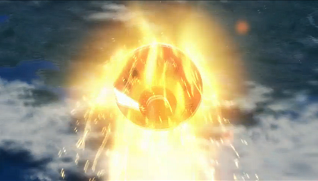
It cost a then-huge $18 million, was enjoyed by millions all over the world and was nominated for several Oscars – and yet it still wasn’t the biggest science fiction film of 1977.
Whether Steven Spielberg was unlucky that Close Encounters of the Third Kind was released a few months after his friend George Lucas’s Star Wars is difficult to judge.
But one thing I do believe about Close Encounters, having recently watched the 1977 theatrical release for the first time in many years, is this: It comes very close to being a defining classic of the genre – yet falls frustratingly short.
The structure of Close Encounters is elegantly simple. A number of people see UFOs and are subsequently haunted by visions of a big flat-topped mountain shape. It turns out that the shape they are seeing is the outline of Devils Tower in Wyoming, where mankind is on course to have its first contact with visitors from another planet.
Close Encounters took cinema SF forward in huge leaps in many respects. Its visual effects are ravishingly good. The cinematography by Vilmos Zsigmond. John Williams’ score is one of the best ever, perfectly fused with the visuals.
What’s more, Close Encounters presented a vision of ‘first contact’ with aliens that was infinitely more convincing than anything we had seen before. In so many SF movies, the viewer has to make allowances for the aliens rapidly learning English (stereotypically, they would then announce that they had been travelling for many thousands of our Earth years). In Spielberg’s vision, the whole climax is built around ETs and humans achieving a halting conversation through a limited musical vocabulary, and the emotional high point comes when one of the visitors mimics a human smile.
The exhilarating, aesthetically gorgeous climax almost puts Close Encounters alongside 2001: A Space Odyssey as a game-changing masterpiece of SF. To examine the reasons it does not quite get there, it might help to look at a couple of sequences earlier in the film.

First, there is the sequence in which the single mother Jillian Guiler (Melinda Dillon) desperately tries to prevent the aliens from carrying off her three-year-old son Barry (Cary Guffey) from their house. It’s a great suspense set piece. You can detect its influence, not in other SF movies so much, but in the slasher horror film cycle that would begin within a year or two of its release. The more successfully Jillian blocks the entry points to the house, the more deviously the aliens find others, until he finally disappears through the cat flap.
This is all very exciting and scary, but it points up one of the film’s central problems: The aliens are presented as frightening and indifferent to human suffering here, and yet we’re supposed to forget about all this when they turn out to be peaceful at the climax. True, Barry is returned to his mother at the end, and we could surmise that the aliens didn’t perceive that their actions would be seen as hostile; but that doesn’t quite smooth out this contradiction.
Similarly, when the alien mothership lands towards the end of the film, a procession of earthly abductees from different eras stream out, including a number of World War II pilots. Again, we could reason that the extra-terrestrials meant no harm when they yanked these people out of their proper times and places, returning them decades later to a world that will have changed immeasurably. That’s fine, but the film doesn’t attempt to deal with what it must be like to be abducted and returned to Earth when many of your friends and family will have given you up or died. Addressing these knotty subjects would detract from the inspirational climax.

The second key sequence is the one in which Richard Dreyfuss as UFO contactee Roy Neary, despite having tried to put his initial close encounter behind him, finds himself driven to build a large replica of Devils Tower. He shovels dirt and chicken wire into the family living room, unable to resist his compulsion any more, and all this finally persuades his wife Ronnie (Teri Garr) to take the children and leave.
In many ways it’s an impressive sequence, as Neary wrecks his home to create a giant monument to his alien-inspired obsession in the very spot where his family should be safest. (It does sometimes feel, though, that these scenes are a bit of an indulgence, and are allowed to run on to show us what a fine actor Richard Dreyfuss is.) But it all points to the film’s biggest problem: If Neary has been driven to wreck his family’s security and scare them away from him, how are we supposed to forget about all this at the climax? We’ve already seen a moving scene in which Neary reassures his children that despite all the recent craziness, he’s “still dad”. That reassurance has turned out to be desperately hollow, but once the wife and kids are out of his life, the film asks us to forget about them.
Spielberg clearly knew there was something amiss in this sequence. In the 1980 Special Edition of the film, he practically excised it, and instead structured the story so that the kids seem brattier and Ronnie much less sympathetic. But tweaking the story to make the family easier to leave is surely a bit low.
Again, the film might get away with all this if it could convince us that Neary’s family break-up is the tragic collateral damage of events which change the future of the planet. That’s all well and good, but again, the tone of the climax contains no such emotional ambiguity. When Neary takes his fateful step into the spaceship at the end of the movie, it is clear he’s getting his heart’s desire. There are even a few bars of ‘When You Wish Upon A Star’ played on the soundtrack (and a full version is played in during the end credits of the Special Edition). There is little doubt that the ending is supposed to be purely and simply uplifting.
Come the 21st century, when Spielberg had another go at reshaping his film for a Director’s Cut, he acknowledged that he would not have made it the same way if he could have his time over again. Now that he had children, he said, he could not conceive of ending the story with Neary leaving his family.
Close Encounters remains the only film on which Spielberg takes sole credit for the screenplay, and it is possible to read some autobiographical significance into the film. We could speculate that Spielberg – whose father had left his household in the director’s childhood – achieved some satisfaction from creating a story in which a father has an important and compelling reason to leave his family behind. It would also be possible, if mischievous, to read the alien forces in Close Encounters as being like Hollywood in Spielberg’s life. His generation of film-makers had tended to regard the big studios as untrustworthy, even malevolent – but Spielberg, who was taken under their wing more than most of his contemporaries, perhaps concluded that they were benign after all once you saw them up close.
Close Encounters created a lot of excitement at the time, and was regarded by plenty of people as SF for adults, in comparison with the unashamedly juvenile Star Wars. Yet I can’t help thinking that its writer-director had not quite achieved the intellectual or emotional maturity to make the film cohere into the masterpiece it could have been.










